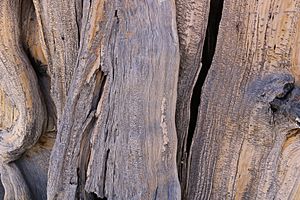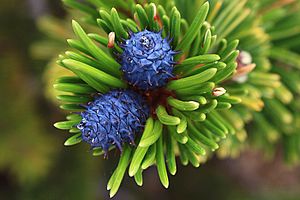Bristlecone pine facts for kids
Quick facts for kids Bristlecone pine |
|
|---|---|
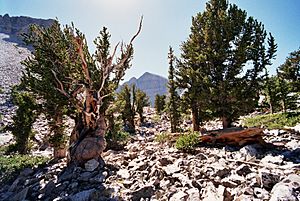 |
|
| A Great Basin bristlecone pine grove | |
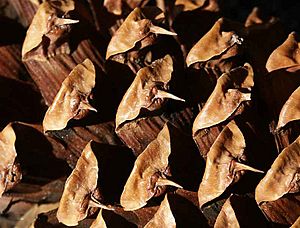 |
|
| The eponymous bristles | |
| Scientific classification |
|
| Kingdom: | Plantae |
| Clade: | Tracheophytes |
| Division: | Pinophyta |
| Class: | Pinopsida |
| Order: | Pinales |
| Family: | Pinaceae |
| Genus: | Pinus |
| Subgenus: | P. subg. Strobus |
| Section: | P. sect. Parrya |
| Subsection: | P. subsect. Balfourianae |
| Species | |
Bristlecone pines are three special types of pine trees. They are known for living a very long time. These trees are also super tough and can survive in harsh weather and poor soil. One kind, called Pinus longaeva, is among the oldest living things on Earth! The oldest known tree of this type is over 4,800 years old. That's older than many ancient civilizations!
Even though they live a long time, bristlecone pines don't have many young trees. They are often the first plants to grow in new, open areas. They don't do well where other plants thrive, like in gardens. In fact, they can quickly get root rot there. But they are amazing in places where most plants can't grow. This includes rocky soils with almost no rain.
Bristlecone pines grow in small groups high up in the mountains. You can find them in dry parts of the Western United States. Like all conifers, they are seed plants that grow cones. Their name comes from the small prickles found on their female cones.
Types of Bristlecone Pines
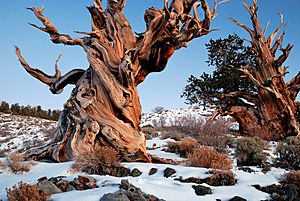
There are three types of bristlecone pines that are closely related:
- Great Basin bristlecone pine (Pinus longaeva): This type grows in Utah, Nevada, and eastern California. It's the famous species known for living the longest. When people say "bristlecone pine," they often mean this tree.
- Rocky Mountain bristlecone pine (Pinus aristata): You can find this one in Colorado, New Mexico, and Arizona. It's the most common type. Unlike the others, it can grow in thick forests. People also grow this one in gardens more easily.
- Foxtail pine (Pinus balfouriana): This tree grows in two separate areas. One is in the Klamath Mountains and the other in the southern Sierra Nevada. It forms the thickest groups of trees among the three types.
These three species can mix and create new trees if planted together. However, in nature, they grow in different areas. Large rivers and valleys keep their natural homes separate.
What Bristlecone Pines Look Like
Bristlecone pines grow in scattered groups just below the tree line. This is usually between 1,700 and 3,400 meters (about 5,600 to 11,200 feet) high. They prefer rocky soils that are high in calcium and magnesium. These special soils make it hard for other plants to grow. This allows bristlecones to do well.
Because of the cold, dry soil, strong winds, and short growing seasons, these trees grow very slowly. Their needles grow in bunches of five. These needles can stay on the tree for up to forty years! This makes the ends of their branches look like long bottle brushes.
The roots of a bristlecone pine are mostly shallow and spread out. A few larger roots help the tree stand strong. These roots, along with their waxy needles, help the tree save water. This makes them very good at handling dry conditions.
The wood of these trees is very hard and full of sticky sap. This helps protect them from bugs and fungi. The wood's toughness is a big reason why these trees live so long. Other nearby trees might rot, but bristlecone pines can last for centuries. Even after they die, they often stay standing. Their exposed wood doesn't rot. Instead, it slowly wears away like stone from wind, rain, and freezing. This creates their unique, twisted shapes.
Bristlecone pines don't have many young trees growing. Some worry that not enough new trees are growing to keep their numbers stable. These species are on a list called the International Union for Conservation of Nature (IUCN) red list. This means they are being watched. However, most bristlecone pine groups are stable or even growing. Many places where they live are now protected. This includes the Ancient Bristlecone Pine Forest in California. In these areas, it's against the rules to cut or collect their wood.
The green pine needles give the twisted branches a "bottle-brush" look. The needles cover the branch for about a foot near the tip. The name "bristlecone pine" comes from their dark purple female cones. These cones have small, sharp prickles on them. The dark color of the cones helps them soak up heat. After about two years, the cones turn brown. These old trees often look twisted and short, especially those growing high up. They have reddish-brown bark with deep cracks. As the tree gets older, much of its living tissue might die. In very old trees, only a thin strip of living tissue connects the roots to a few live branches. Even though their needles get old, they still work well. They help the tree control water and make food from sunlight.
The Oldest Living Things
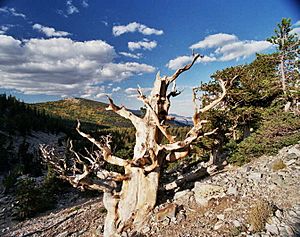
Bristlecone pines are famous for how old they get. The oldest known bristlecone pine is named Methuselah. It is over 4,800 years old! This amazing tree lives in the Inyo National Forest in California. Its exact location is kept secret to protect it.
The other two types of bristlecone pines also live long. They can reach up to 3,000 years old. Scientists think these trees live so long because they have a lot of dead wood compared to living wood. This helps them use less energy and lose less water. This makes their lives longer.
Some living things are even older than bristlecone pines. These are plants that reproduce by cloning. For example, a group of 47,000 quaking aspen trees called "Pando" in Utah. This whole group is thought to be 80,000 years old! But each individual tree above ground only lives about 130 years.
Bristlecone pines are very important to scientists who study past climates. These trees provide the longest continuous record of climate changes on Earth. By studying the tree rings of old bristlecone pine wood, scientists can learn about climates from over 9,000 years ago. They can also study the chemicals in the rings to understand past rainfall.
The bristlecone pines in the Rocky Mountains face some threats. These include a fungus called white pine blister rust and mountain pine beetles. Climate change might also affect them. Temperatures have risen in the Rocky Mountains. This could mainly affect trees at higher elevations. Despite these problems, old bristlecone pines have survived warmer times before.


